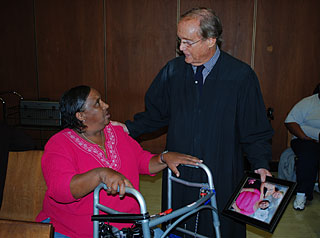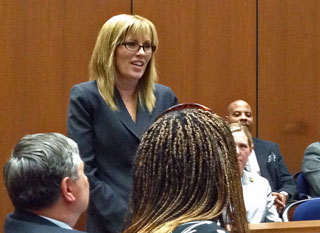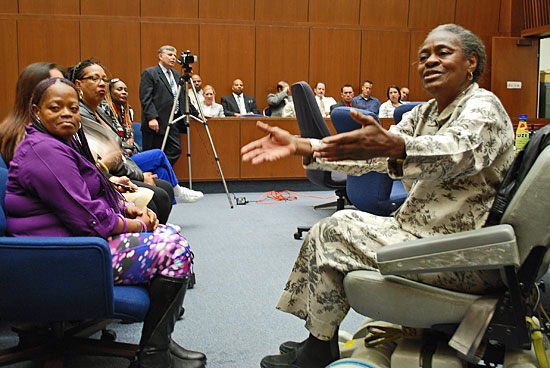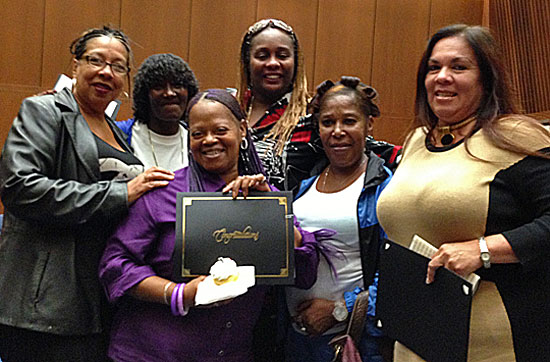Embracing a second chance
November 25, 2013
Gratitude is rare in criminal courtrooms, but for the women gathered on a recent Friday before Los Angeles Superior Court Judge Michael Tynan, thanksgiving was everywhere.
One was clean after an addiction that had crippled her since age 7. Another was in sober living after 30 years of shuttling between Skid Row and prison. Yet another was a middle-aged ex-con when she hit her deepest bottom, and she wept as she described the redemption she shared with the five women beside her.
“I was so tired,” 55-year-old Donna Majors said last week, as prosecutors and parole officers brushed away their own tears at the small graduation ceremony in Tynan’s downtown courtroom. “And I was given the chance to finally face my demons, to know who I am and finally be at peace.”
If the emotional scene seems a far cry from standard L.A. criminal justice, it may be because the program that spawned it is a departure as well. Since 2007, the Second Chance Women’s Re-Entry Court has been among the most successful diversion programs in Los Angeles County, offering an intensive yet cost-effective alternative to prison for hundreds of high-risk female felons.
The program targets parolees and probationers charged with new offenses, channeling them into a 6-month residential substance abuse treatment program in lieu of another term behind bars. That rehab, at the nonprofit Prototypes residential center in Pomona, is followed by up to 18 months of tightly supervised outpatient treatment, plus services ranging from parenting classes to educational and vocational training.

Judge Tynan greets program alum Georgina Moore, who presented him with a picture of her and her daughter.
Each woman checks in regularly before Tynan, who consults with therapists and court officers to determine when a participant can move to the next level of treatment. Those who relapse or reoffend return—often remorsefully—to county jail or prison, but most move on to sober housing, family reconciliation and even jobs and college.
At last count, 295 women had been formally admitted and 61 had gone back to jail or prison, according to a recent review conducted by the Public Defender’s Office. About 90% of the recidivists, the review found, were women who had not yet completed their treatment.
Of the 125 who have graduated so far, the review found, only eight—about 6%—have since gone back to jail or prison. By comparison, according to state figures, the recidivism rate in 2011 was 55.1% for female inmates.
“You’ve come a long way,” the judge told a glowing ex-con at the most recent graduation ceremony, glancing at a file that included her latest report card from Mt. San Antonio Community College. “You got an A at Mt. SAC! Congratulations! Gimme a hug! I remember when you came through that door looking like something the cat wouldn’t have dragged in on a bet.”
Well into his 70s, Tynan notes that he could be retired. But the judge—who also presides over the county “drug courts” and alternative sentencing programs for the mentally ill, military veterans and others—says that his is a labor of love.
This has been particularly true lately, he adds, as funding concerns have been looming over the program because of a new state law aimed at putting the brakes on California’s burgeoning state prison population. Under the AB 109 law, known as “realignment,” the county, rather than the state, has been given responsibility for supervising and incarcerating offenders whose most recent convictions are for non-serious, non-violent, non-sexual offenses.
But because the Women’s Re-Entry Court is largely underwritten by a state grant for parolees, women who once were prime candidates for the program—street people, hustlers and others whose long criminal histories stem from drug habits—are now ineligible because the state no longer supervises them.
And the county, which now oversees these offenders, doesn’t directly fund its Re-Entry Court participants. Under AB 109, these offenders are being channeled into other, less intensive programs underwritten by realignment money. If they re-offend now, they can only be placed in Re-Entry Court if an alternative funding source pays for their treatment—a grant for AIDS patients, for example, or for pregnant women.
Meanwhile, officials say that parolees who remain under state supervision now often require special consideration to get into the program, because they are more institutionalized, with more serious convictions.
Shari Crome, an assistant unit supervisor with the California Department of Corrections and Rehabilitation, says she’s frustrated “because I’ve been here almost since the beginning of the program, and I’ve seen the successes. There’s nothing else like it in the state, and it works.”

Deputy Public Defender Nancy Chand, a key member of the re-entry court team, congratulates the grads.
Deputy Public Defender Nancy Chand, who has represented most of the Re-Entry Court women, calls the AB 109 funding snag a rare sour note in a program that has transformed some of the most desperate lives in L.A.
“These women are really scarred,” Chand says. “Most come in with horrific trauma, and were victimized as children, enduring severe physical, sexual and emotional abuse and abandonment. Some can’t read and write. Some can’t work. Eighty-one percent have one or more mental health diagnosis and 50 percent have two or more. As one of my clients put it, they’re literally scraped off the streets.”
Currently, Tynan says, about 60 women at any given time are enrolled in the program, a little more than half of them paid for through the $500,000 annual state correction’s grant and the rest covered by a shifting and uncertain patchwork of federal, state and county grants to Prototypes.
The cost is about $18,000 a year for each woman, versus an incarceration cost of close to $50,000 a year in prison or more than $36,000 a year in county jail, not counting medical and mental health care. Officials at the Public Defenders Office estimate the program has saved tens of millions of dollars; many of its participants had been facing jail or prison sentences of 10 years or more.
Barbara Dunlap, for instance, was a 58-year-old homeless addict with 15 prison terms under her belt by the time she entered the program.
“I discovered alcohol before I started school, and I started school at the age of six,” Dunlap says. Her babysitter sold her to men when she was a child and by 21, she says, she was a prostitute with a criminal record. By the time her public defender sent her to Tynan’s courtroom, she was a 58, suffering from AIDS and hepatitis and was wheelchair-bound as the result of surgery stemming from a poisoned heroin injection.
Now 61, she is sober, living in permanent supportive housing, enrolled in college classes and a mentor at Prototypes. And at the ceremony in Tynan’s courtroom, she addressed the most recent graduates from her electric wheelchair, rolling back and forth across the courtroom, testifying like a preacher as a dozen state corrections officials watched from the jury box.
“When they found me, I was on the streets, and I don’t even know how they told me from the sidewalk—I was cold, my life was filled with stench and I was gray, without any life in me,” she proclaimed, her voice trembling.
“But they treated the whole woman—my health issues, my substance abuse issues, my anger issues. I didn’t know that anyone understood people like me.”
Taking the podium in Dunlap’s wake, the graduates told their own harrowing stories, weeping with gratitude as they thanked their therapists, probation and parole officers, prosecutors and defenders, families and, of course, the judge.
Brigitte Benjamin, 52, told the group that she had spent 30 years on Skid Row, and had expected to die there. Now, she is in a sober living facility and working toward her GED after 30 years on Skid Row.
Helen Navarro credited Tynan and Prototypes with forcing her to confront the roots of her addiction for the first time in the 20 years she had spent cycling in and out of prison on robbery and burglary charges. “I didn’t want to go deep-deep-deep,” said Navarro, a 51-year-old recovering crack addict—now sober and working as a receptionist at a country club in the San Gabriel Valley. “The counselors made me look at myself.”
Sandy Raymond, a 48-year-old mother of two who had lost more than half her life to crack addiction, did a little dance as Tynan handed her a certificate of completion. “I didn’t know nothing but going in and out of jail and stealing stuff,” she said. “But now I’m a secretary. I love my life.”
Over cupcakes and high fives from their families, the women also quietly gave thanks for the inner strength they were able to muster.
Brandishing her graduation certificate after decades of crime and addiction, Mary Willis said that for the first time in 25 years, she now has a relationship with her children. “I will always keep in the back of my mind what Judge Tynan told me,” she said proudly. “Give yourself a chance.”
Posted 11/25/13















 405 bridge work causes a stink
405 bridge work causes a stink
